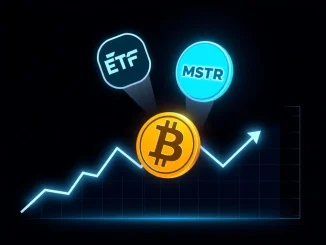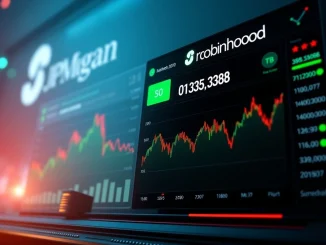
The long-standing debate between gold and Bitcoin as store-of-value assets continues to capture market attention. Adding a new layer to this discussion, Jurrien Timmer, the head of global macro at financial giant Fidelity, recently shared insights that suggest a potential turning point. His observations focus on the historical performance relationship between the two assets and what their current metrics, specifically the Sharpe Ratio, might indicate for the near future.
What Did Jurrien Timmer Observe About Bitcoin vs Gold?
On social media, Jurrien Timmer pointed out a notable trend: gold and Bitcoin have often exhibited a negative correlation. This means that when one asset performs well, the other tends to underperform, and vice versa. This inverse relationship is significant because it highlights their different market drivers and investor bases, even though both are sometimes viewed through a similar ‘digital gold’ or ‘safe haven’ lens.
Timmer’s analysis delves into the Sharpe Ratio, a key metric used to evaluate the performance of an investment by adjusting for its risk. A higher Sharpe Ratio indicates better risk-adjusted returns. Timmer noted that the leadership in Sharpe Ratio between gold and Bitcoin has historically alternated.
Currently, the numbers present an interesting picture:
| Asset | Current Sharpe Ratio (as noted by Timmer) |
|---|---|
| Bitcoin | -0.40 |
| Gold | 1.33 |
These figures, as highlighted by the Fidelity macro expert, suggest that gold has recently offered superior risk-adjusted returns compared to Bitcoin. However, Timmer’s core point is that the historical pattern of alternating leadership in this metric could imply that Bitcoin is now positioned to potentially outperform gold in the period ahead, reversing the current trend.
Why Does This Sharpe Ratio Comparison Matter for the Crypto Outlook?
Understanding the Sharpe Ratio helps investors gauge whether an asset’s returns are simply due to taking on excessive risk or if they represent genuinely strong performance relative to that risk. Bitcoin is known for its volatility, which often results in a lower or more fluctuating Sharpe Ratio compared to less volatile assets like gold, especially during downturns.
Timmer’s observation isn’t just about the current numbers; it’s about the historical cycle. If the pattern of alternation holds, the current situation (where gold has a much higher Sharpe Ratio) might signal that Bitcoin’s turn for stronger risk-adjusted performance is approaching. This perspective from a respected voice at Fidelity provides valuable context for those evaluating both traditional and digital assets.
Considering the Potential Shift: What Does It Mean?
A potential shift from gold to Bitcoin, or even just Bitcoin outperforming gold, has several implications:
- It could signal increasing investor confidence in Bitcoin as a viable store of value or even a growth asset.
- Capital flows might shift, with some investors reallocating funds from gold or other traditional hedges into Bitcoin.
- It reinforces the idea that Bitcoin’s market cycles can differ significantly from traditional assets, offering diversification potential.
While Jurrien Timmer‘s note is a specific observation based on historical patterns and current metrics, it aligns with the broader narrative of Bitcoin maturing as an asset class and gaining acceptance among institutional players and macro strategists.
Challenges and Considerations
It’s important to remember that market predictions are not guarantees. Several factors could influence whether this potential shift truly materializes:
- **Macroeconomic Environment:** Interest rates, inflation, and global economic stability impact both gold and Bitcoin differently.
- **Regulatory Developments:** Increased clarity or new regulations around cryptocurrencies could affect investor sentiment and Bitcoin’s price.
- **Bitcoin’s Volatility:** Despite its growth, Bitcoin remains significantly more volatile than gold, which affects its Sharpe Ratio over different timeframes.
- **Market Sentiment:** Broader risk-on or risk-off sentiment in the market plays a crucial role.
Actionable Insights for Investors
Timmer’s observation from Fidelity serves as a prompt for investors to:
- Review their portfolio allocation between traditional assets like gold and digital assets like Bitcoin.
- Consider the risk-adjusted return potential of different assets based on metrics like the Sharpe Ratio.
- Stay informed about macro trends and expert analysis from institutions like Fidelity.
- Conduct their own research and understand the risks associated with investing in volatile assets like Bitcoin.
Compelling Summary
Jurrien Timmer’s analysis highlights a fascinating potential shift in the market dynamic between gold and Bitcoin. By noting their historical negative correlation and the alternating leadership in their Sharpe Ratios, he suggests that despite gold’s current advantage in risk-adjusted returns, Bitcoin may be poised for a period of outperformance. This perspective from a leading voice at Fidelity underscores the evolving landscape of asset classes and provides a compelling point for investors to consider when evaluating their Crypto Outlook alongside traditional hedges like gold. While market movements are complex and influenced by many factors, Timmer’s observation adds weight to the argument that Bitcoin continues to carve out its unique role in the global financial picture.



